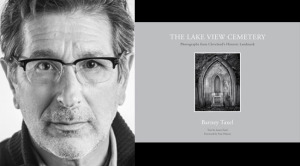Photographer Barney Taxel: Vision, Place, Heart & Journey

Barney Taxel began seriously exploring a beloved garden cemetery with cameras in tow in 2000. The commercial and fine art photographer had to whittle down thousands of color and black-and-white images to arrive at the roughly 200 that appear in this newly released book, The Lake View Cemetery: Photographs from Cleveland’s Historic Landmark. This labor of love became even more personal when he chose to collaborate his wife, author and journalist Laura Taxel, to help tell the story. “She has amazing ability to reflect an experience through words,” says Barney. “[She had to get] me to tell her things I ordinarily wouldn’t think of expressing verbally because I am a photographer, but we both came out of the process feeling very good about how we worked together.” In fact, Barney’s feeling so good about the project overall that even after 14 years his interest in the cemetery hasn’t waned. “I didn’t expect to still be interested in continuing on after ‘buttoning up’ the book but the cemetery’s sesquicentennial is coming up in 2019 and I fully anticipate doing something supplemental to honor that celebration,” he explains. “Personally, if I am at Lake View Cemetery now without my camera I feel weird now. It means something to me.” We met him for talk about the book at a cozy coffee shop just steps away from the 285-acre cemetery.
Why Lake View Cemetery?
It hadn’t been done before and it offered a huge variety of subject matter—cultural, natural, historical, artistic and seasonal. [It offers] a real sense of place and a sense of intention in terms of design. Also, there is a kind of non-sectarian spirituality that emanates from it.
What do you see with your camera that I might not notice as a casual observer?
As a professional photographer, I am trained to look at things from the widest scale to the smallest minutiae. There are some inscription images in the book that are maybe only a couple of inches in diameter in real life. They’re Civil War-era and inscribed into marble that shows their age. To me it’s amazing what can be communicated in such a small landscape. And then I show this very wide view of Cleveland from the portico on the [James A.] Garfield Monument.
What changes seasonally for you?
Well, I have to wear different clothing. (Laughing.) It’s fun for me. I feel that a lot of photographers—especially now in contemporary times—pigeonhole themselves. Like “Oh, I am only an oak leaf photographer. That’s what I do. That’s what I love and that’s all you’re going to see from me.” I am just the opposite. I am curious about everything, especially the universality of impressions. The variety provides me with some sort of nourishment and I am always looking.
So nothing won out for you? You didn’t prefer, say, flora and fauna over art and architecture in the cemetery?
In the editing process actually had to take out some of the nature. I didn’t know this about myself but apparently I love photographing trees, grass and water. The first edit may have been 700 to 1000 images and I had bring it down to 200 or 250. The vast majority of images that came out in that first pass were photos of leaves, branches and rocks.
Talk more about that editing process. You had to find some sort of balance of what? Seasonality? Subject matter? Representation of spaces within the cemetery?
It presented a real challenge. I am interested in discovering what’s real right in front of me rather than prescribing to some pre-conceived notion of things. The obvious ways to put this book together would have been either by season or by subject matter. I just didn’t want to do that. It’s what was expected. I wanted to explore something different and interesting to me. I thought that maybe I could divide the material in terms of the human experience. There are four sections: the vision, the place, the heart and the journey. In my own mind I saw it as akin to putting together a symphony with four movements. Each movement might have a different tempo, a different pitch or some variations on a theme. When I sit down and listen to a symphony maybe I can tell where I am by certain indications but don’t literally know where I am in the music. That’s how we did it and the approach appears to be working. The response has been very warm in relation to the story being told in this different way.
To see photos from the book or to find dates of book signings and author talks, click here.

















